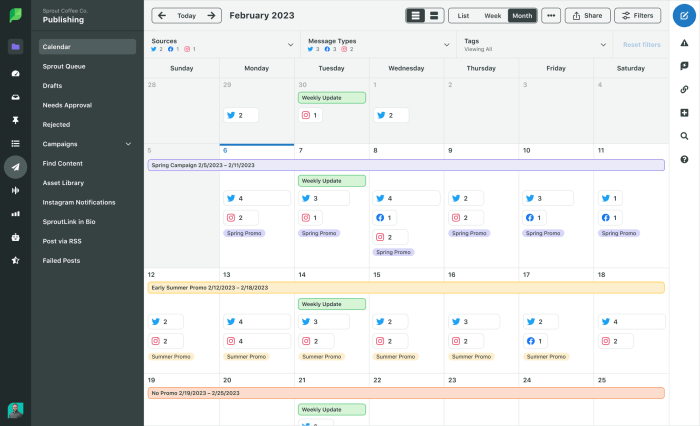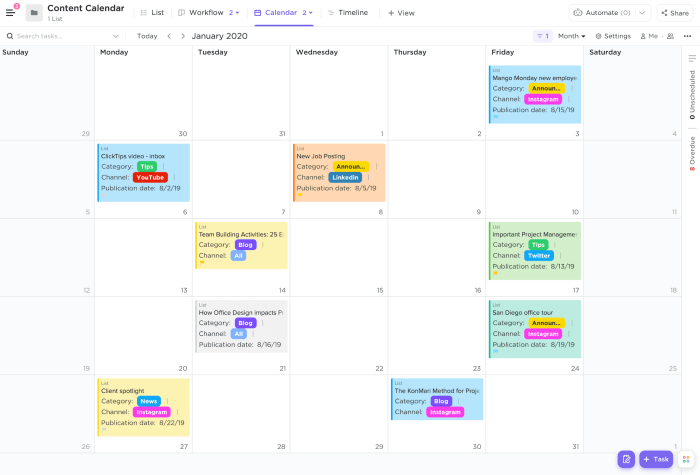Building a Content Calendar sets the foundation for seamless content creation and organization, paving the way for success in your digital endeavors. From structure to strategy, dive into the essentials of crafting a calendar that fuels your content journey.
Importance of a Content Calendar
Yo, listen up! Having a content calendar is like having your game plan laid out for you in advance. It’s crucial for keeping your content creation on point and organized.
Improved Workflow and Organization
With a content calendar, you can see at a glance what content needs to be created and when it needs to go live. This helps you stay on track, meet deadlines, and work efficiently.
Don’t be out here scrambling last minute to come up with content ideas. A content calendar keeps you ahead of the game!
Benefits of Content Planning and Scheduling
- Allows for strategic planning: You can align your content with marketing campaigns, events, or seasons for maximum impact.
- Consistent posting schedule: A content calendar helps you maintain a regular posting schedule, which is key to keeping your audience engaged.
- Improved content quality: When you plan ahead, you have more time to create high-quality content that resonates with your audience.
Elements of a Content Calendar
Creating a content calendar involves including essential components, structuring it efficiently, and categorizing content effectively.
Essential Components
- Dates and Deadlines: Include important dates for content creation, publication, and distribution.
- Content Topics: List out the main themes or topics to be covered in your content calendar.
- Content Types: Specify the format of content, such as blog posts, social media posts, videos, etc.
- s and : Incorporate relevant s and strategies for each piece of content.
- Assigned Responsibilities: Assign tasks to team members responsible for creating and publishing content.
Structuring for Maximum Efficiency
- Use a digital tool or spreadsheet to create and manage your content calendar for easy access and updates.
- Color code or label different types of content to visualize and organize your calendar effectively.
- Include a clear workflow with stages like ideation, creation, editing, and publishing for each piece of content.
- Set realistic timelines and deadlines to ensure timely delivery of content.
Tips for Categorizing Content
- Group content based on themes, target audience, or marketing goals to maintain a cohesive strategy.
- Segment content by platform or channel to tailor it according to the specific requirements of each medium.
- Consider the buyer’s journey stages and align content accordingly to guide users through the sales funnel.
- Utilize labels or tags to easily filter and search for content within your calendar.
Creating a Content Calendar: Building A Content Calendar

To create a content calendar from scratch, you need to follow a structured process that involves several key steps. This will help you organize your content strategy effectively and ensure consistency in your publishing schedule.
Step 1: Define Your Goals and Audience
Start by clearly defining your content marketing goals and identifying your target audience. Understanding who you are creating content for and what you want to achieve will guide the rest of the calendar creation process.
Step 2: Conduct Content Audit
Review your existing content and identify any gaps or areas for improvement. This will help you determine what type of content you need to create and how it aligns with your goals and audience.
Step 3: Brainstorm Content Ideas
Gather your team and brainstorm content ideas that resonate with your audience and align with your goals. Consider different content formats such as blog posts, videos, infographics, and social media posts.
Step 4: Determine Content Themes and Topics
Based on your goals and audience preferences, decide on the overarching themes and specific topics you want to cover in your content calendar. This will help you maintain a coherent and consistent content strategy.
Step 5: Choose a Content Calendar Tool, Building a Content Calendar
There are various tools and software available to help you build and manage your content calendar efficiently. Some popular options include Trello, Asana, CoSchedule, and Google Calendar. Choose the one that best suits your team’s needs and workflow.
Step 6: Create a Content Calendar Template
Develop a content calendar template that includes important details such as publication dates, content titles, s, target audience, and assigned team members. This template will serve as a roadmap for your content creation process.
Step 7: Populate Your Content Calendar
Once you have your template ready, start populating your content calendar with the planned themes, topics, and publication dates. Make sure to include any relevant deadlines, promotions, or events that may impact your content schedule.
Step 8: Review and Adjust Regularly
Regularly review and adjust your content calendar based on performance metrics, audience feedback, and industry trends. Stay flexible and be willing to make changes to ensure your content remains relevant and engaging.
Maintaining and Updating a Content Calendar

Regularly updating and maintaining a content calendar is crucial for staying organized, on track, and ensuring that your content aligns with your overall marketing strategy.
Importance of Regular Updates
- Keeps content fresh and relevant
- Helps in identifying gaps or overlaps in content
- Ensures alignment with current trends and industry developments
Strategies for Keeping a Content Calendar Up-to-Date
- Schedule regular review sessions to assess the calendar
- Use tools and software to automate updates and reminders
- Delegate responsibilities to team members for specific tasks
- Stay flexible and make adjustments as needed
Tips for Adjusting a Content Calendar
- Prioritize content based on goals and objectives
- Consider shifting deadlines or publishing dates if necessary
- Be open to adding or removing content based on changing priorities
- Communicate changes effectively with team members
